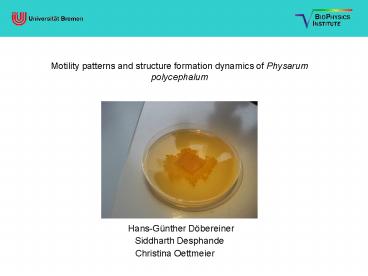PowerPointPrsentation - PowerPoint PPT Presentation
1 / 15
Title:
PowerPointPrsentation
Description:
Cell motility in the slime mold. amoeboid movement and muscle cell ... direction of movement is determined by chemotaxis, negative phototaxis. 2/14 ... – PowerPoint PPT presentation
Number of Views:137
Avg rating:3.0/5.0
Title: PowerPointPrsentation
1
Motility patterns and structure formation
dynamics of Physarum polycephalum
Hans-Günther Döbereiner
Siddharth Desphande
Christina Oettmeier
2
Introduction
Cell motility in the slime mold
amoeboid movement and muscle cell contraction
both based on sliding filament mechanism of actin
and myosin
http//academic.wsc.edu/faculty/jatodd1/351/ch6out
line.html
The principles of this mechanism have not
changed during evolution
1/14
3
Introduction
Cell motility Why investigate slime molds?
direction of movement is determined by
chemotaxis, negative phototaxis
new perspectives can be developed with todays
advanced knowledge in biology and physics
2/14
4
Introduction
Physarum polycephalum A slime mold conquers the
lab
Complex network formation (see poster S.
Desphande, session P3, Wed 1715, BP 17.42)
3/14
5
Introduction
Life cycle of Physarum polycephalum
haploid amoebal phase
Plasmodium feeding stage
diploidal plasmodial phase (multinucelated,
synchronous mitosis)
4/14
6
Material Methods
Slime mold plasmodia were cultivated on solid,
semi-defined nutrient medium 24C, 50 rel.
humidity incubator inverted microscope (Zeiss
Observer) equipped with an AxioCam MRm camera
record the behaviour of a fragment ( 1mm Ø) over
variable time spans
5/14
7
Material Methods
Growth cones Oscillations
as described in the literature (e.g. by
Wohlfahrt-Bottermann 1979), Physarum plasmodia
perform rhythmic oscillations with a period in
the order of a minute
Wohlfahrt-Bottermann, K.E., Oscillatory
contraction activity in Physarum, J. Exp. Biol.
(1979), 81, 15-32
6/14
8
Setup
record images
Fast Fourier Transformation of radius
7/14
9
Results
Power spectrum
Square of amplitudes
mode
8/14
10
Results
mode 0 (square of radius) increases
growth
9/14
11
Results
mode 2 (ellipse)
10/14
12
Results
mode 3 (asymmetry) increases
11/14
13
Results
mode 4 (four-leaved-clover) increases
12/14
14
Conclusion
Preliminary findings show
patterns of movement can be described
quantitatively
future work deficiency mutants, (actin and/or
myosin) inhibitors ...
Physarum very sensitive to chemicals
ideal bioindicator organism
13/14
15
Acknowledgments
Special thanks to Prof. Dr. Wolfgang Marwan (MPI
Magdeburg) for providing the slime molds
Thanks to Hans-Günther Döbereiner Siddharth
Desphande Pavel Rhyzkov Fabian Heinemann































